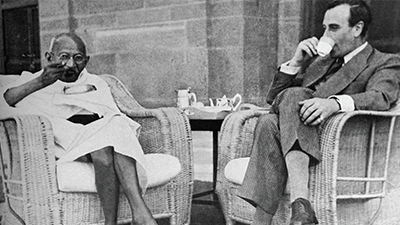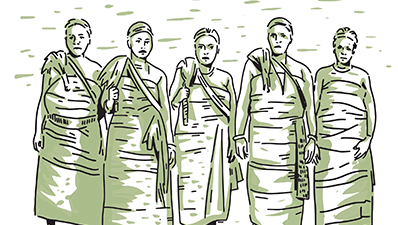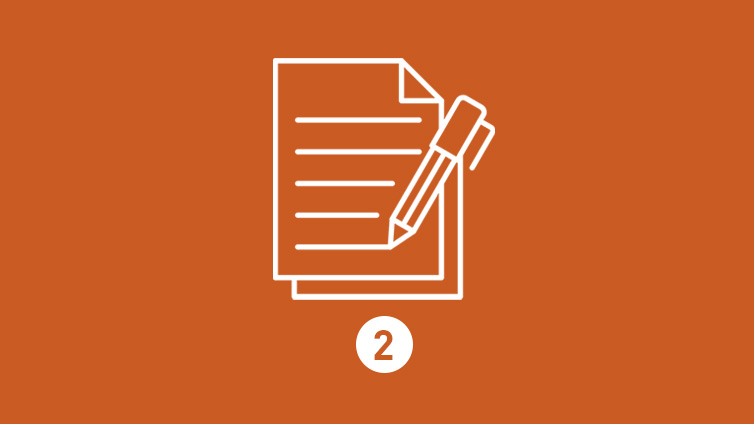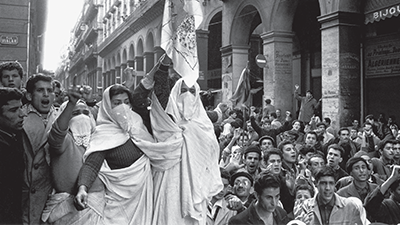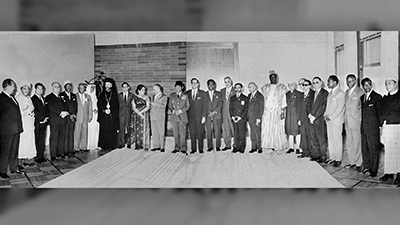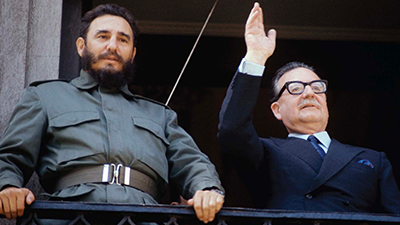Decolonization
Driving Question: How were the Cold War and decolonization entangled?
As colonized nations fought for independence, Cold War politics influenced their paths. From Ghana to Vietnam, you'll compare struggles, examine women’s roles in decolonization, and connect local resistance to global power shifts.
Learning Objectives:
- Use the historical thinking practices of contextualization and causation to analyze connections between the Cold War and decolonization.
- Use evidence to compare the roles women played in anticolonial movements around the world.
- Create arguments using historical evidence to support claims, and communicate conclusions through informal writing.
Vocab Terms:
- decolonization
- dependency
- ideology
- nationalist
- nonviolence
- partition
Opener: Decolonization
To teach this lesson step, refer to page 2 of the Lesson 8.9 Teaching Guide.
Start by exploring the global tensions that shaped the fight for independence. This activity introduces how the Cold War became a battleground of ideas for newly decolonizing nations.
Comparing Decolonization Struggles
To teach this lesson step, refer to page 3 of the Lesson 8.9 Teaching Guide.
Want to dive deeper into the Ghanaian Independence movement? Take a look at the graphic biography of Kwame Nkrumah, who was vital to the Ghanaian independence movement.
Remind students to use their historical comparison skills as they work through this activity. The Comparison One-Pager can provide a nice refresher on how we approach this skill in the course.
By comparing cases like Ghana, India, Vietnam, Nigeria, and Algeria, you’ll uncover how the global struggle between the United States and Soviet Union influenced local fights for independence—bringing both support and conflict to anticolonial movements.
-
Guiding Questions
-
Before you watch
Preview the questions below, and then review the transcript.
While you watch
Look for answers to these questions:
- What did historian A. Adu Boahen mean when he said independence was “won by blood”?
- Who was Yaa Asantewaa, and what made her a symbol of resistance?
- What was the Golden Stool, and why did the British want it?
- Why was some resistance directed at local chiefs and kings?
- What roles did the UGCC and veterans play in postwar resistance?
After you watch
Respond to this question: Using the communities frame, what motivated resistance in Ghana?
Key Ideas
-
Guiding Questions
-
Before you read
Preview the questions below, and then skim the article. Be sure to look at the section headings and any images.
While you read
Look for answers to these questions:
- What was the necessary condition for a colonized people to end colonial rule? Why?
- What ideologies helped people resist colonial rule?
- How did anti-colonial struggles attempt to change the mindset of their colonizers? What regions were more successful?
- Which of these four nations engaged in violent struggles? Which attempted nonviolence? Were their outcomes different?
- What happened to the nationalist movements’ unity after achieving independence?
After you read
Respond to this question: All four of the nations compared in this article were successful at ending colonial rule and all are independent today. What do you think are the most important similarities among all four that help explain this success?
Women and Decolonization
To teach this lesson step, refer to page 7 of the Lesson 8.9 Teaching Guide.
Looking for a way to shorten this activity? There are some great ideas in the Decolonizing Women thread in the Community Forum.
Discover the roles women played in challenging imperialism. These materials highlight how gender shaped both colonial rule and independence movements across the globe.
-
Guiding Questions
-
Before you read
Preview the questions below, and then skim the article. Be sure to look at the section headings and any images.
While you read
Look for answers to these questions:
- Why were African women often left out of official colonial records?
- How did colonial rule change women’s roles?
- Why did colonial rulers rely on “warrant chiefs”?
- How did European ideas about gender shape policies toward African women?
- How did Egyptian women respond to the exile of anticolonial leaders?
After you read
Respond to these questions: The author argues that colonialism often harmed women more than men. What evidence supports this idea? Do you agree? Why or why not?
Closer: Decolonization
To teach this lesson step, refer to page 10 of the Lesson 8.9 Teaching Guide.
Check out the OER Project Informal Writing Routines Guide to generate other ideas about how to help students show their thinking through writing.
Use this informal writing opportunity to reflect on how local and global struggles for justice were connected and what those connections reveal about the world today.
Women’s Resistance Efforts
To teach this lesson step, refer to page 11 of the Lesson 8.9 Teaching Guide.
Research and compare the ways in which women across Nigeria, Algeria, and Egypt resisted colonial oppression.
-
Guiding Questions
-
Before you read
Preview the questions below, and then skim the article. Be sure to look at the section headings and any images.
While you read
Look for answers to these questions:
- What was the Cold War?
- What was decolonization?
- How did the Cold War and decolonization overlap?
- How might a person living in a colonized or decolonizing country have viewed these two conflicts?
After you read
Respond to this question: Do you think a nation can truly decolonize if its independence is shaped by superpower agendas?
-
Guiding Questions
-
Before you read
Preview the questions below, and then skim the article. Be sure to look at the section headings and any images.
While you read
Look for answers to these questions:
- What was the Double-V campaign?
- How did Hitler use racism in the United States to support his arguments?
- How did anticolonial leaders influence the US civil rights movement?
- Why did civil rights activism create a problem for US foreign policy during the Cold War?
- What role did international events play in shaping civil rights efforts in the United States?
After you read
Respond to this question: How does this article support or challenge the idea that civil rights movements were part of global struggles linked to the Cold War and decolonization?
-
Guiding Questions
-
Before you read
Preview the questions below, and then skim the article. Be sure to look at the section headings and any images.
While you read
Look for answers to these questions:
- In what way is Latin American history like a pendulum?
- How did Latin American politics shift to the left before World War II?
- What changes occurred after World War II that made politics more radical?
- How did neoliberalism affect Latin America?
- How did global and local forces shape these shifts?
After you read
Respond to these questions: Do these changes in modern Latin America feel more like revolutions or cycles of change? Why?
-
Guiding Questions
-
Before you watch
Preview the questions below, and then review the transcript.
While you watch
Look for answers to these questions:
- What is the difference between a liberal revolution and a social revolution?
- Which two parties competed to lead China in the 1920s and 1930s?
- What inspired the Chinese Communist Revolution from inside and outside China?
- How did the Communist Party respond to Japanese occupation during the war?
- Was the Chinese Communist Revolution an anticolonial struggle?
After you watch
Respond to this question: How does the Chinese Communist Revolution help you understand the connection between Cold War politics and global decolonization?


